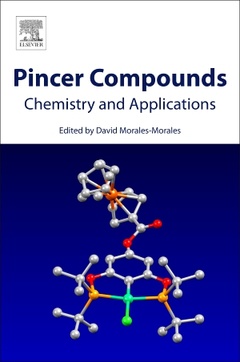Pincer Compounds Chemistry and Applications
Coordonnateur : Morales-Morales David

Pincer Compounds: Chemistry and Applications offers valuable state-of-the-art coverage highlighting highly active areas of research?from mechanistic work to synthesis and characterization. The book focuses on small molecule activation chemistry (particularly H2 and hydrogenation), earth abundant metals (such as Fe), actinides, carbene-pincers, chiral catalysis, and alternative solvent usage. The book covers the current state of the field, featuring chapters from renowned contributors, covering four continents and ranging from still-active pioneers to new names emerging as creative strong contributors to this fascinating and promising area.
Over a decade since the publication of Morales-Morales and Jensen?s The Chemistry of Pincer Compounds (Elsevier 2007), research in this unique area has flourished, finding a plethora of applications in almost every single branch of chemistry?from their traditional application as very robust and active catalysts all the way to potential biological and pharmaceutical applications.
1. Chiral Pincer Complexes for Asymmetric Reactions Jun-ichi Ito and Hisao Nishiyama 2. Well-defined Iron and Manganese Pincer Catalysts Nikolaus Gorgas and Karl Kirchner 3. The Pincer Complexes of Group 13-15 Elements: Recent Developments Libor Dostal and Roman Jambor 4. Reduction of CO2 Mediated or Catalyzed by Pincer Complexes Nathan A. Eberhardt and Hairong Guan 5. Mechanistic Insights and Computational Prediction of Base Metal Pincer Complexes for Catalytic Hydrogenation and Dehydrogenation Reactions Xinzheng Yang and Xiangyang Chen 6. Hydrogenation and Dehydrogenation Reactions Catalyzed by Iron Pincer Compounds Wesley H. Bernskoetter and Nilay Hazari 7. Actinide Pincer Chemistry: A New Frontier Connor S. MacNeil, Tara K.K. Dickie and Paul G. Hayes 8. Complexes of NHC-Based CEC Pincer Ligands: Structural Diversity and Applications Caroline M. Storey, Hans P. Cook and Adrian B. Chaplin 9. Transition Metal Pincer Complexes With Chiral Imidazoline Donor(s): Synthesis and Asymmetric Catalysis Jun-Fang Gong, Xinju Zhu and Mao-Ping Song 10. Chiral NCN Pincer-Type Catalysts Having Bis(imidazoline)s Kengo Hyodo and Shuichi Nakamura 11. Transition Metal Pincer Complexes with a Central sp3-Hybridized Carbon Atom Ola F. Wendt 12. CCC-NHC Pincer Complexes: Synthesis, Applications, and Catalysis Jason A. Denny, Georgette M. Lang and T. Keith Hollis 13. Metal Pincer Catalysts in Aqueous Media: Approaches With Water as Solvent, Reagent, and Molecular Hydrogen Storage Jong-Hoo Choi, Hugo Valdes, Dennis Pingen and Martin H.G. Prechtl 14. Pincers Based on Dicarboxamide and Dithiocarboxamide Functional Groups Pramod Kumar, Sandeep Kaur, Rajeev Gupta and Kristin Bowman-James 15. Pincer Complexes of Iron and Their Application in Catalysis Anu Saini and Michael Findlater 16. Osmium Complexes With POP Pincer Ligands Miguel A. Esteruelas and Montserrat Olivan 17. Pincer Carbenoid Complexes With Late Transition Metals: Synthesis, Electronic Structure, and Reactivity Peng Cui and Vlad M. Iluc 18. Pincer Iridium and Ruthenium Complexes for Alkane Dehydrogenation Huaquan Fang, Guixia Liu and Zheng Huang 19. Silicon-Based Pincers: Trans Influence and Functionality Eduardo Sola 20. Transition Metal Complexes With Anionic Sulfur-Based Pincer Ligands Ivan Castillo 21. Metalation and Transmetalation Chemistry of Pyridine- and Aryl-Linked Bis-NHC Pincer Ligands Matthew Asay 22. Unsymmetrical Pincer Palladacycles Synthesis and Reactivity Gavin Roffe, Sarote Boonseng, Hazel Cox and John Spencer 23. Benzene-Derived Organometallic Pincer Compounds Bearing Six-Membered Metallacycles and Up Lucero Gonzalez-Sebastia´ n, Daniel Canseco-Gonzalez and David Morales-Morales 24. Chemistry of Mn and Co Pincer Compounds Naveen V. Kulkarni and William D. Jones 25. Selective Deuteration of Organic Compounds Catalyzed by Ruthenium Pincer Complexes Basujit Chatterjee and Gunanathan Chidambaram 26. s-Organometallic Chemistry With 2,6-Bis(imino)pyridine Ligands: New Pathways to Innovative Pincer Architectures Juan Campora, Antonio Rodriguez-Delgado and Pilar Palma 27. Use of Pincer Compounds as Metal- Based Receptors for Chemosensing of Relevant Analytes Alejandro Dorazco-Gonzalez 28. Advances in the Design and Application of Redox-Active and Reactive Pincer Ligands for Substrate Activation and Homogeneous Catalysis Jarl Ivar van der Vlugt 29. The Chemistry of Bisphosphomide and 1,2-Phenylenediamine Based PBP Pincer Transition Metal Complexes and Catalytic Applications Maravanji S. Balakrishna and Latchupatula Radhakrishna 30. Ligand-Introduction Synthesis of NCN-Pincer Complexes and their Chemical Properties Yasuhiro Uozumi and Go Hamasaka 31. Pincer Complexes of Gold: An Overview of Synthesis, Reactivity, Photoluminescence, and Biological Applications Benoit Bertrand, Manfred Bochmann, Julio Fernandez-Cestau, and Luca Rocchigiani 32. Semirigid Pincer-Like SiPSi Ligands: Classical Versus Nonclassical Coordination Modes at Ru, Rh, Ir, and Pt Julio Zamora-Moreno and Virginia Montiel-Palma 33. Conclusions and Personal Comment Gerard van Koten
Researchers in metal-mediated organic synthesis, homogeneous catalysis, and organometallics. Students in organometallic chemistry
- Describes the chemistry and applications of this important class of organometallic and coordination compounds
- Includes contributions from global leaders in the field, featuring pioneers in the area as well as emerging experts conducting exciting research on pincer complexes
- Highlights areas of promising and active research, including small molecule activation, earth abundant metals, and actinide chemistry
Date de parution : 04-2018
Ouvrage de 754 p.
21.4x27.6 cm
Thèmes de Pincer Compounds :
Mots-clés :
Acceptorless dehydrogenation; Actinides; Activation; Alcohol oxidation; Alkane dehydrogenation; Amine oxidation; Aminophenol; Anion hosts; Anticancer; Aqueous catalysis; Asymmetric Michael reaction; Asymmetric catalysis; Asymmetric reactions; Base metal pincer complexes; Biphasic catalysis; Bis(imidazoline)s; Bis(imino)pyridine; Bisphosphomide; CH bond activation; CCC-NHC; CO2 activation; Carbene; Carbenes; Carbenoid; Carbon dioxide; Catalysis; Catalyst; Catalytic applications; Central sp3-hybridization; Chelates; Chemosensing; Chiral ligands; Chiral pincer complex; Cobalt; Complex; Computational catalyst design; Computational quantum chemistry; Concept of the pincer ligand; Coordination chemistry; Coupling reactions; Cyclometalation; Cytotoxicity; C-H activation; C−H activation; DFT; Dehydrogenation; Dehydrogenation reactions; Density functional theory; Deuteration; Dicarboxamide and dithiocarboxamide pincers; Dihydrogen; Diiminopyridine; Electrocatalysts; Electron reservoir; Enantioselectivity; Energy storage; Formaldehyde reforming; Future directions; Gold complex; H/D exchange; Homogeneous catalysis; Hydrides; Hydrido complex; Hydroamination; Hydroboration; Hydroformylation; Hydrogen generation; Hydrogenation; Hydrogenation and dehydrogenation reactions; Hydrogenation reactions; Hydrophosphination; Hydrosilation; Hydrosilylation; Imidazoline ligand; Ion pair hosts; Iridium; Iridium complexes; Iron complexes; Late transition metals; Lewis acid; Ligand-introduction route; Liquid organic hydrogen carrier (LOHC); Low-valent species; Macrocyclic pincers; Main group elements; Main-group organometallic chemistry; Manganese; Manganese complexes; Mechanism; Metal catalysis; Metal-ligand cooperation; Metalation; Methanol reforming; Mizoroki-Heck reaction; Molecular recognition; NCN pincer-type complex; NCN-pincer complexes; NHC; Nickel



